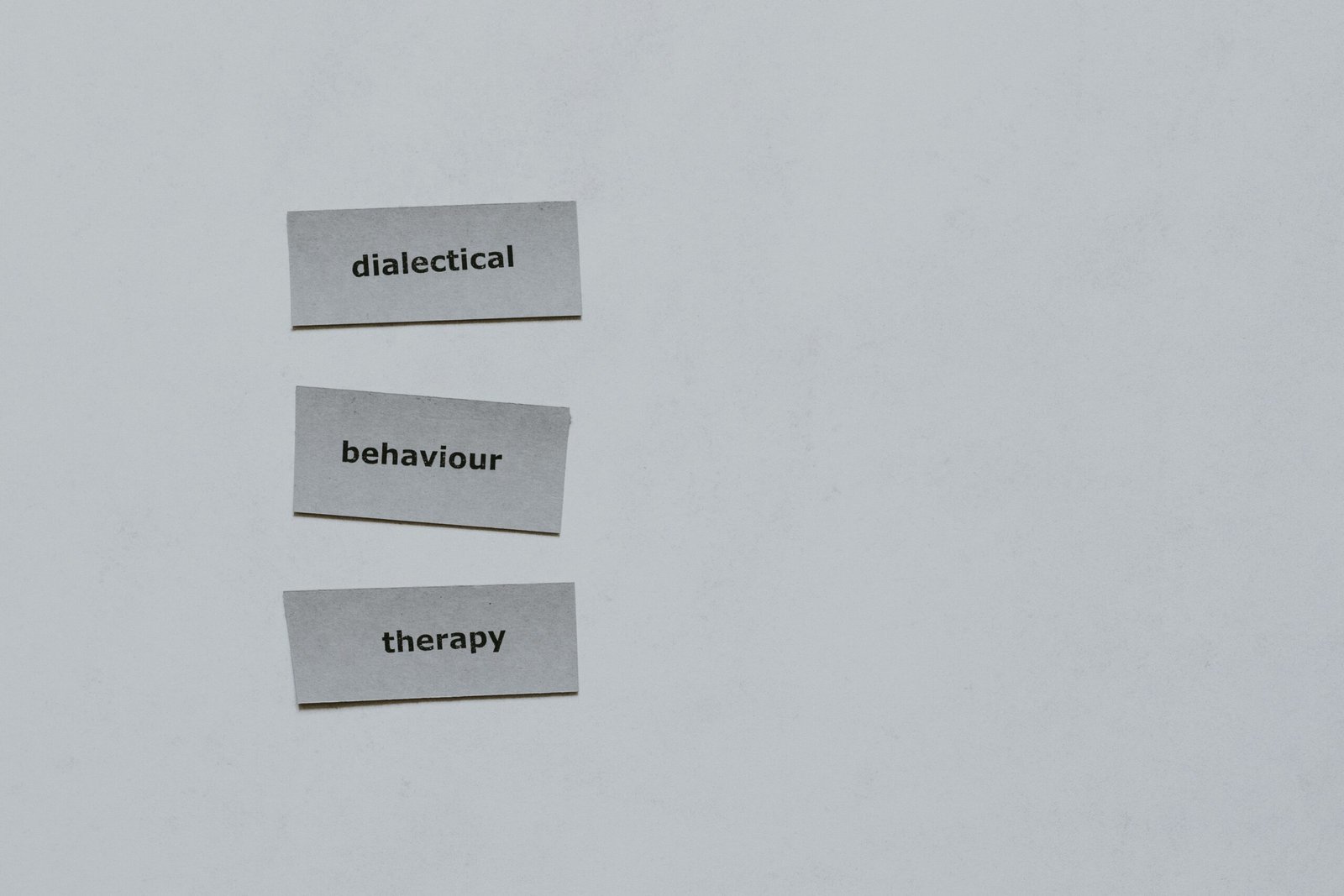Dialectical Behavioural Therapy (DBT) is a type of psychotherapy that was originally developed to treat individuals with Borderline Personality Disorder (BPD) now also referred to as Emotionally Unstable Personality Disorder or EUPD.
Over time, its effectiveness has been recognized in helping people with a range of mental health conditions and emotional states, including trauma, PTSD, ADHD, eating disorders, suicidal thoughts and those struggling with conflict in relationships.
In this article, we will explore how DBT works, which patients can benefit from it, the number of sessions typically required for positive outcomes and how it differs from Cognitive Behavioural Therapy (CBT).
How Does DBT Work?
DBT is a multifaceted approach designed to help individuals navigate the complexities of their emotions and foster a life worth living. We’ll return to this in a minute, but first, let’s start with the word “dialectics” which at first sight, isn’t easy to grasp.
In simple terms, dialectics means two opposing things being true at the same time. For example, you might love your mother but at the same time find her annoying. These two different ways of feeling about your mother may seem to contradict each other BUT they are both true at the same time.
Dr. Marsha M. Linehan who developed DBT in the late 1980s, and herself living with BPD, defines dialectical as a synthesis or integration of opposites. In other words, it aims to change something while at the same time radically accepting that it is what it is. To explain this further, think about a situation where you’re doing okay but want to be doing better. You’re a runner, for example, and quite pleased with your personal best on a park run AND you want to run even faster. You accept where you’re at and want to improve, at the same time.
As such, DBT as a whole is centered on one main, overarching dialectic: acceptance AND change. For the treatment to work, therapists and patients need to balance the two strategies, not focusing too much on either side.
So let’s return to the nuts and bolts of DBT. It’s a multifaceted approach designed to help individuals who feel emotions intensely to lead a better life.
It combines elements of Cognitive Behavioural Therapy (CBT) with mindfulness practices. The main goal of DBT is to help individuals develop skills to manage their emotions, improve their relationships, and enhance their overall quality of life.
DBT typically consists of individual therapy sessions, group skills training, phone coaching, and therapist consultation teams. Individual therapy sessions focus on helping the person identify and change problematic behaviours, thoughts, and emotions. Group skills training provides education and practice in four key areas: mindfulness, distress tolerance, emotion regulation, and interpersonal effectiveness. Phone coaching allows individuals to reach out to their therapist for support between sessions, and therapist consultation teams provide guidance and support to the therapists delivering DBT.
Core Components
In DBT, individuals are taught skills that enable them to experience their emotions without necessarily acting on them. They are also taught to replace problematic behaviors, such as self-injury or bingeing and purging, with skillful ones. DBT provides therapeutic skills in four key areas:
- Mindfulness: DBT places a significant emphasis on mindfulness, urging individuals to be fully present in the current moment without judgment. Mindfulness techniques, such as meditation and deep-breathing exercises, enable individuals to observe and accept their thoughts and feelings non-judgmentally. This heightened awareness serves as a foundation for other DBT skills, fostering emotional regulation and resilience.
- Distress Tolerance: Life is rife with challenges and crises, and DBT equips individuals with distress tolerance skills to navigate these moments without resorting to harmful behaviors. By accepting distressing situations and learning healthy distraction techniques, individuals gain the resilience needed to weather the storms of life without compromising their well-being.
- Emotion Regulation: One of DBT’s primary objectives is to empower individuals to identify, understand, and manage their emotions effectively. Emotion regulation skills involve recognizing and labeling emotions, understanding the functions they serve, and implementing strategies to modify or cope with intense feelings. This component is particularly beneficial for those prone to emotional dysregulation.
- Interpersonal Effectiveness: Building and sustaining healthy relationships is paramount for mental well-being. DBT integrates interpersonal effectiveness skills, teaching individuals how to communicate assertively, set boundaries, and navigate social interactions while maintaining self-respect. These skills are instrumental in fostering positive connections with others and reducing interpersonal conflicts.
Aims of DBT therapy sessions
The purpose of individual DBT therapy sessions aims to address various aspects of an individual’s mental health and well-being. Here are some key purposes:
Assessment and Goal Setting: Individual DBT sessions typically begin with a comprehensive assessment of the individual’s current mental health status, identifying specific areas of concern and assessing the severity of symptoms. Therapists work collaboratively with clients to establish treatment goals that are specific, measurable, achievable, relevant, and time-bound (SMART). This goal-setting process helps create a roadmap for the therapy journey.
Targeting Problematic Behaviors: DBT often involves addressing and changing specific problematic behaviors that contribute to emotional distress and interpersonal difficulties. Individual sessions provide a private and confidential space for individuals to explore these behaviors, understand their underlying triggers, and work with the therapist to develop strategies for change.
Skill Building and Reinforcement: DBT is known for its emphasis on skill-building in areas such as mindfulness, distress tolerance, emotion regulation, and interpersonal effectiveness. Individual sessions offer an opportunity for in-depth instruction, practice, and reinforcement of these skills. Therapists guide individuals in learning and applying these skills to manage daily challenges and enhance their overall well-being.
Validation and Support: Individuals undergoing DBT often face intense emotions and challenging situations. Individual therapy sessions provide a safe and supportive environment where individuals can express their thoughts and feelings without judgment. Therapists use validation techniques to acknowledge the individual’s experiences and emotions, fostering a sense of understanding and empathy.
Behavioral Analysis: A significant component of DBT involves conducting behavioral analyses of specific situations or events. Individual sessions allow therapists to work closely with clients to dissect problematic situations, identify triggers, and understand the chain of events leading to maladaptive behaviors. This analysis informs the development of more effective coping strategies.
Crisis Management: DBT incorporates strategies for crisis management, and individual sessions are crucial for creating and refining an individualized crisis plan. Therapists and clients collaborate to develop strategies that can be implemented during times of acute distress, helping prevent harmful behaviors and enhance emotional regulation.
Feedback and Modification of Treatment Plan: Individual DBT sessions provide a platform for ongoing feedback. Therapists assess the progress individuals are making toward their treatment goals, modify strategies as needed, and explore any challenges or barriers that may arise. This iterative process ensures that the treatment plan remains dynamic and responsive to the individual’s evolving needs.
Generalisation of Skills: While DBT skills are initially learned and practiced in the therapeutic setting, individual sessions focus on generalizing these skills to real-life situations. Therapists work with individuals to apply newly acquired skills in various contexts, promoting a more adaptive and resilient response to the challenges of daily life.
Radical Acceptance
Radical acceptance is a key concept in Dialectical Behavior Therapy (DBT) that involves fully and completely accepting the reality of a situation without judgment. Radical acceptance is a crucial skill within the mindfulness component of DBT. It encourages individuals to embrace the present moment, even when faced with painful or distressing circumstances.
Here are the key elements and principles of radical acceptance in DBT:
Acceptance without Judgment: Radical acceptance emphasizes accepting the current reality without judgment, criticism, or a desire for it to be different. It involves acknowledging that some aspects of life are beyond one’s control and resisting the urge to label them as “good” or “bad.”
Acknowledging Reality: It’s about acknowledging the facts of a situation as they are, not as one wishes them to be. This doesn’t mean condoning or approving of the situation but recognizing its existence and the limitations of control.
Letting Go of Resistance: Resistance to reality can contribute to increased emotional distress. Radical acceptance involves letting go of the resistance to what is happening and recognizing that fighting against the unavoidable only intensifies suffering.
Living in the Present Moment: Radical acceptance encourages individuals to focus on the present moment rather than dwelling on the past or worrying about the future. By being fully present, individuals can reduce the emotional burden associated with ruminating on what has happened or anticipating what might happen.
Nonjudgmental Stance: It’s crucial to adopt a nonjudgmental stance toward oneself and others. This means refraining from harsh self-criticism or blaming others for the situation. Instead, individuals are encouraged to approach themselves and others with compassion and understanding.
Openness to Possibilities: Radical acceptance opens the door to exploring new possibilities and coping strategies. When individuals accept the reality of a situation, they can better focus on problem-solving and making decisions based on the facts rather than emotional reactions.
Reducing Emotional Suffering: By embracing radical acceptance, individuals can reduce emotional suffering associated with prolonged distress. Acceptance does not imply approval but rather a willingness to acknowledge and work with the reality at hand.
Increasing Emotional Regulation: Radical acceptance is closely tied to emotion regulation in DBT. By accepting reality, individuals can avoid getting entangled in overwhelming emotions, allowing them to respond more effectively to challenging situations.
Radical acceptance is particularly relevant in situations where change is difficult or impossible, such as dealing with a chronic illness, the loss of a loved one, or external circumstances beyond one’s control. It is a skill that, when mastered, contributes to a more balanced and resilient approach to life’s challenges. It complements other DBT skills, such as distress tolerance and emotion regulation, by providing a foundation for coping with difficult realities and fostering a mindset conducive to personal growth and well-being.
Differences between DBT & CBT
Dialectical Behavior Therapy (DBT) and Cognitive-Behavioral Therapy (CBT) share common roots in cognitive and behavioral theories but differ in their approaches, emphasis, and applications. Here are key distinctions between DBT and CBT:
Dialectical Approach:
- DBT: DBT incorporates dialectics, emphasizing the synthesis of seemingly opposing viewpoints. It encourages individuals to accept the contradictions in their lives, finding a balance between acceptance and change.
- CBT: CBT typically focuses on changing negative thought patterns and behaviors through cognitive restructuring. It seeks to identify and challenge distorted thinking to modify emotional responses.
Emphasis on Acceptance:
- DBT: Radical acceptance is a core concept in DBT, encouraging individuals to fully accept the reality of a situation without judgment. Mindfulness practices play a significant role in promoting acceptance.
- CBT: While CBT acknowledges the importance of acceptance, its primary focus is often on changing cognitive distortions and behaviors through challenging and modifying irrational thoughts.
Mindfulness:
- DBT: Mindfulness is a central component of DBT, with specific exercises and practices integrated into the therapy. Mindfulness skills help individuals stay present, observe their thoughts and feelings without judgment, and enhance emotional regulation.
- CBT: Mindfulness may be used in CBT, but it is not as central to the approach. CBT typically places more emphasis on cognitive restructuring and behavioral techniques.
Target Population:
- DBT: Originally developed for individuals with Borderline Personality Disorder (BPD), DBT has demonstrated effectiveness in treating a range of emotional dysregulation issues, including mood disorders, self-harm, and substance abuse.
- CBT: CBT is widely used across various mental health conditions, including anxiety disorders, depression, phobias, and post-traumatic stress disorder (PTSD).
Therapeutic Relationship:
- DBT: The therapeutic relationship in DBT is collaborative and validating. Therapists use supportive techniques, acknowledgment, and validation to enhance the therapeutic alliance.
- CBT: The therapeutic relationship in CBT is typically collaborative but may focus more on the cognitive restructuring process and problem-solving.
Time Orientation:
- DBT: DBT often incorporates a balance between acceptance of the present and a commitment to change for the future. It addresses immediate crisis management while working towards long-term goals.
- CBT: CBT tends to be future-oriented, focusing on identifying and changing cognitive patterns to influence future behaviors and emotional responses.
Approach to Change:
- DBT: DBT emphasizes finding a balance between acceptance and change. Change strategies are introduced gradually, with a focus on building a life worth living and improving the quality of life.
- CBT: CBT is more direct in targeting and changing specific thoughts and behaviors. It often involves homework assignments and structured interventions to modify cognitive distortions.
Application to Severe Emotional Dysregulation:
- DBT: Particularly effective in addressing severe emotional dysregulation, self-harm, and suicidal behaviors. Skills training, crisis management, and validation are integral to DBT.
- CBT: Effective across a range of mental health conditions, but may be adapted for individuals with less severe emotional dysregulation.
While both DBT and CBT share the goal of improving mental health and well-being, their differences lie in their philosophical underpinnings, therapeutic techniques, and target populations. The choice between DBT and CBT often depends on the specific needs and characteristics of the individual receiving therapy. Some therapists may integrate elements of both approaches based on the unique requirements of their clients.
Conclusion
DBT is a highly effective therapy approach that has helped many individuals with various mental health conditions. By combining elements of cognitive-behavioural therapy and mindfulness practices, DBT equips individuals with the skills they need to manage their emotions, improve relationships, and enhance their overall well-being. While the number of sessions required can vary, a comprehensive DBT program typically lasts for about one year and includes individual therapy, group skills training, phone coaching, and therapist consultation teams.









